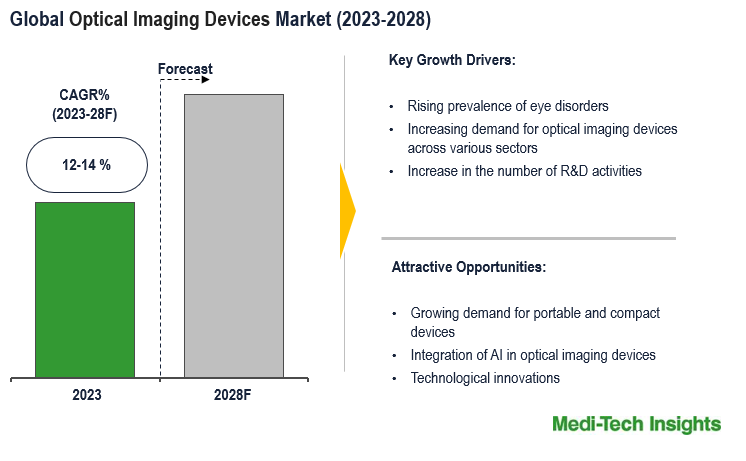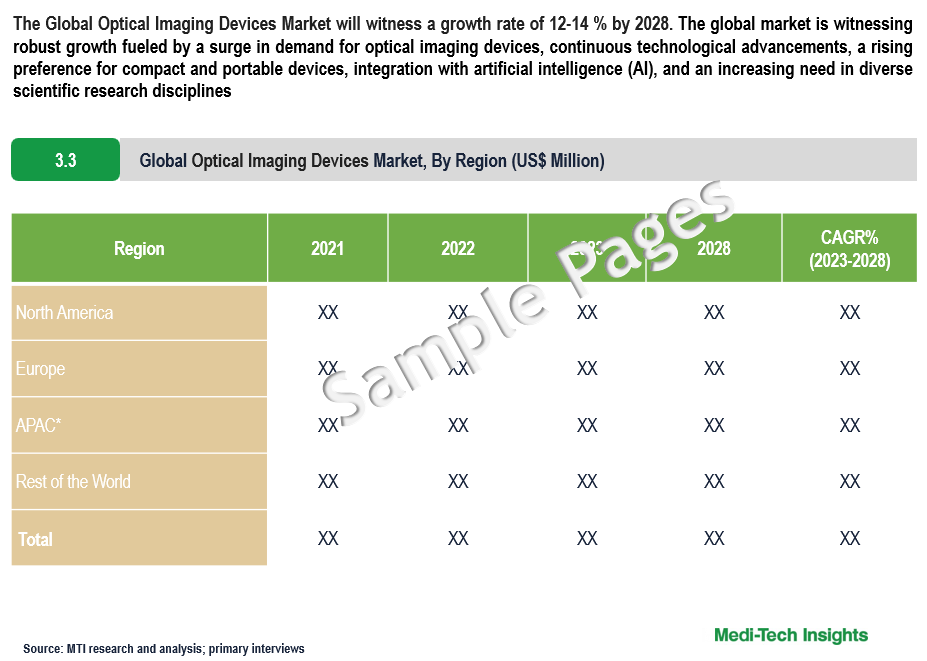
Optical Imaging Devices Market: Global Industry Size, Share, Trends, Growth Analysis and Forecast to 2028
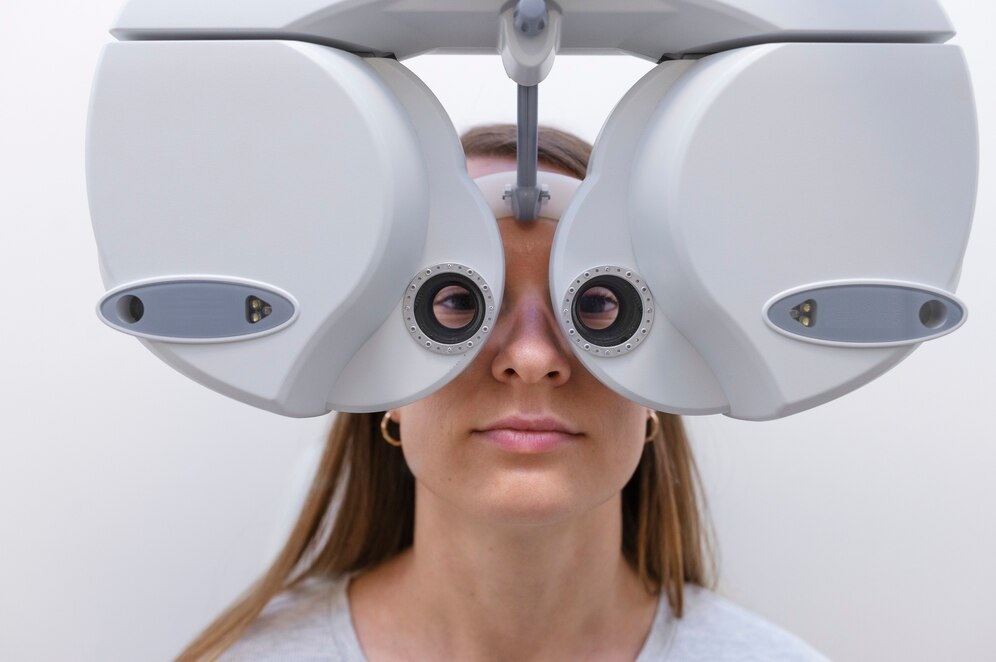
The Global Optical Imaging Devices Market will witness a growth rate of 12-14 % by 2028. The global market is witnessing robust growth fueled by a surge in demand for optical imaging devices, continuous technological advancements, a rising preference for compact and portable devices, integration with artificial intelligence (AI), and an increasing need in diverse scientific research disciplines. To learn more about the research report, download a sample report.
Optical imaging devices utilize visible light or other forms of electromagnetic radiation to capture detailed images of structures within the body, such as organs, tissues, cells, or molecules. These devices leverage the unique properties of photons to create non-invasive images for diagnostic and research purposes. Optical imaging encompasses various techniques, including:
- Endoscopy: This involves a flexible tube equipped with a lighting system to examine organs or tissues internally
- Optical Coherence Tomography (OCT): This technique captures sub-surface images, making it valuable for detailed retinal imaging in ophthalmology and diagnosing conditions like coronary artery disease in cardiology
- Diffuse Optical Tomography (DOT): Used to obtain information about brain activity, DOT provides insights into neural processes by analyzing changes in light absorption
- Raman Spectroscopy: This method relies on Raman scattering of light delivered by a laser. It has diverse applications, such as recognizing chemical compounds and overseeing anaesthetic gas mixtures in medical surgeries
Additionally, optical imaging techniques include Super-resolution Microscopy and Terahertz Tomography, each offering unique capabilities for specific applications in diagnostics, research, and medical interventions.
From Diagnostics to Research: Unveiling the Potential of Optical Imaging
The optical imaging devices market has witnessed substantial growth driven by diverse factors. In the realm of medical imaging applications, there is an increased demand for optical devices in fields like endoscopy, ophthalmology, and microscopy, contributing significantly to market expansion. Ongoing technological advancements in optics, including the development of high-resolution sensors and innovative imaging techniques, have further propelled market growth. The integration of optical imaging with other cutting-edge technologies, such as artificial intelligence (AI) and machine learning, has created a symbiotic relationship, providing opportunities for enhancing image analysis and interpretation. The burgeoning research activities across scientific disciplines such as biology, chemistry, and materials science have also spurred a heightened demand for advanced optical imaging tools, solidifying the market's position as an integral component of scientific and medical advancements.
Several opportunities beckon in the optical imaging devices market, particularly with the burgeoning expansion of markets in emerging economies. The development of compact and portable optical imaging devices, especially for point-of-care medical diagnostics, presents a promising avenue for innovation. Furthermore, the integration of optical imaging with AI and machine learning not only enhances diagnostic capabilities but also opens doors for the development of intelligent imaging systems. This intersection of technologies creates a dynamic landscape with vast potential for growth and exploration. For instance,
- In October 2023, Abbott introduced its innovative vascular imaging platform, driven by Ultreon 1.0 Software, in India. This first-of-its-kind intra-vascular imaging software integrates optical coherence tomography (OCT) with artificial intelligence (AI), delivering physicians a holistic perspective on blood flow and coronary artery blockages.
To learn more about this report, download the PDF brochure
Innovative Synergy: Advancements and Trends in Optical Imaging
The adoption of hyperspectral imaging, allowing the capture and processing of information across the electromagnetic spectrum, stands out as a significant trend. The evolution of three-dimensional imaging technologies, providing depth information and enhancing visualization, has gained prominence across various applications, offering a more comprehensive understanding of complex structures. In the medical field, Optical Coherence Tomography (OCT) has witnessed advancements, particularly in ophthalmology and cardiovascular imaging. The integration of OCT into surgical procedures and diagnostic practices has elevated its role in real-time imaging, contributing to more accurate diagnoses and treatment planning. For instance,
- In November 2023, Leica Microsystems unveiled the Proveo 8 ophthalmic microscope featuring the next-generation Integrated EnFocus intraoperative OCT during the FLORetina ICOOR meeting held in Rome, Italy
- In January 2023, Canon Medical Systems USA Inc. revealed a strategic partnership with ScImage, aimed at expanding and enhancing Canon Medical Systems' influence in hemodynamics through the Fysicon QMAPP Hemo portfolio. This collaboration positions Canon Medical to strengthen its footprint in the cardiac market, delivering innovative solutions and customized business models to meet the diverse needs of clients.
Furthermore, the optical imaging market is experiencing a surge in demand driven by non-invasive techniques. Optical imaging techniques, capable of rapidly evaluating epithelial tissues in hollow organs, provide real-time cancer detection. This methodology aids in the early identification of lesions, guides biopsies and surgeries, informs treatment decisions, and monitors effectiveness. The convergence of these factors is likely to drive substantial demand for optical imaging globally. Non-invasive techniques, such as those used in optical imaging, offer a painless way to visualize internal structures. This stands as a significant advantage over traditional imaging techniques like X-rays and CT scans, which can involve radiation exposure and discomfort. As the optical imaging market continues to surge with innovations, its role in providing painless and comprehensive visualization of internal structures underscores its transformative potential in shaping the future of healthcare practices.
Optical Imaging Device Market: Key Constraints/Challenges
The optical imaging devices market encounters notable challenges influencing its growth. Key hurdles include cost constraints, as the advanced technologies and materials employed in these devices contribute to their huge production expenses, limiting market penetration, particularly in cost-sensitive sectors like healthcare. Regulatory compliance poses another significant challenge, especially in the healthcare industry, where adherence to various standards and certifications is crucial for market acceptance and customer trust.
North America Accounts for the Largest Share of the Global Market
Market dynamics exhibit regional variations, with more established services typically found in developed countries. North America stands out as the predominant market, securing the highest revenue share. This growth is fueled by factors such as the presence of highly skilled professionals, a robust research infrastructure, and favourable government initiatives actively promoting technological advancements through substantial investments. The rapid adoption of cutting-edge products and technologies further propels market expansion in the region.
Meanwhile, the Asia Pacific region is poised to experience the most rapid growth in the forecast period. This acceleration can be attributed to the cost-effectiveness of research, favourable regulatory guidelines, and a growing geriatric population susceptible to chronic diseases. The government's increasing focus on the healthcare sector acts as a pivotal driver, significantly driving the market growth.
Optical Imaging Device Market: Competitive Landscape
Some of the key players operating in the market include Abbott Laboratories, Carl Zeiss Meditec AG., Canon Inc., Topcon Corporation, Perkinelmer Inc., Koninklijke Philips NV, Abbott Laboratories, Leica Microsystems, GE Healthcare, and Siemens Healthineers among others.
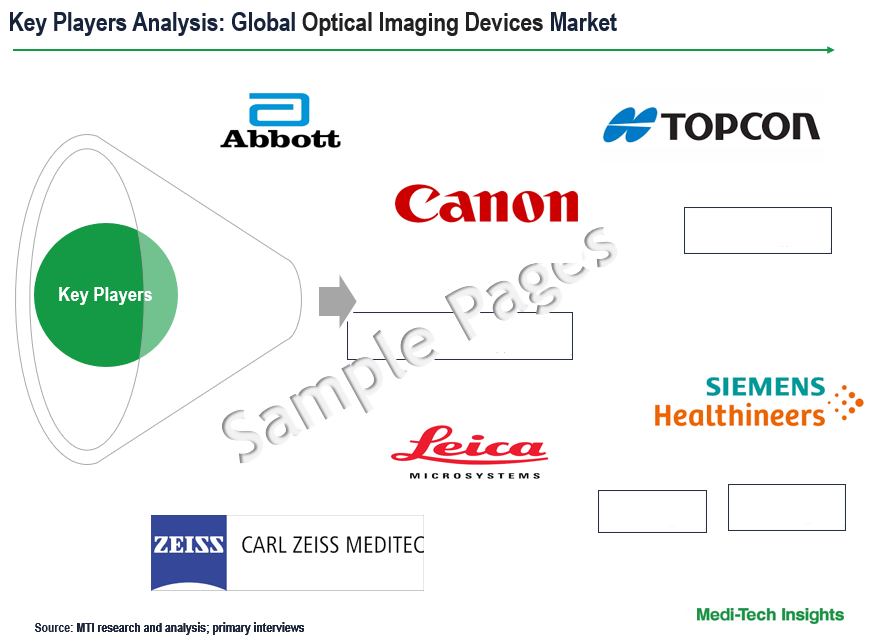
Get a Sample Report for Competitive Landscape Analysis Market
Organic and Inorganic Growth Strategies Adopted by Players to Establish Their Foothold in the Market
Players operating in this market are adopting both organic and inorganic growth strategies such as collaborations, and acquisitions to garner market share. For instance,
- In December 2023, Carl Zeiss Meditec AG revealed its acquisition agreement to purchase 100% of the shares in Dutch Ophthalmic Research Center (International) B.V. (D.O.R.C.) from the investment firm Eurazeo SE, This collaboration will enhance ZEISS Medical Technology’s extensive ophthalmic portfolio and digitally connected workflow solutions, addressing diverse eye conditions such as retinal disorders, cataracts, etc.
- In July 2021, Topcon Corporation completed the acquisition of VISIA Imaging S.r.l, a manufacturer of ophthalmic devices based in suburban Florence, Italy. This strategic move strengthens Topcon's expertise in developing and manufacturing anterior segment devices and software, aligning with its existing portfolio of fundus imaging devices, such as fundus cameras and optical coherence tomography (OCT)
The optical imaging devices market is flourishing, driven by increased demand in medical applications, technological advancements, the integration of AI, and aggressive organic and inorganic growth strategies followed by the players.
Key Strategic Questions Addressed
- What is the market size & forecast for the Global Optical Imaging Devices Market?
- What are the historical, present, and forecasted market shares and growth rates of various segments and sub-segments of the Global Optical Imaging Devices Market?
- How has COVID-19 impacted the Global Optical Imaging Devices Market?
- What are the major growth drivers, restraints/challenges impacting the market?
- What are the opportunities prevailing in the market?
- What is the investment landscape?
- Which region has the highest share in the global market? Which region is expected to witness the highest growth rate in the next 5 years?
- Who are the major players operating in the market? What is the competitive positioning of key players?
- Who are the new players entering the market?
- What are the key strategies adopted by players?
- Research Methodology
- Secondary Research
- Primary Research
- Market Estimation
- Market Forecasting
- Executive Summary
- Market Overview
- Market Dynamics
- Drivers
- Restraints
- Opportunities
- Market Dynamics
- Global Optical Imaging Devices Market - Size & Forecast (2021-2028), By Product
- Imaging Systems
- Illuminating Systems
- Camera
- Software
- Lenses
- Others
- Global Optical Imaging Devices Market - Size & Forecast (2021-2028), By Therapy Area
- Ophthalmology
- Cardiology
- Neurology
- Dermatology
- Others
- Global Optical Imaging Devices Market - Size & Forecast (2021-2028), By Technique
- Optical Coherence Tomography
- Hyperspectral Imaging
- Others
- Global Optical Imaging Devices Market - Size & Forecast (2021-2028), By End User
- Hospitals
- Research Laboratories
- Pharmaceutical & Biotechnology Companies
- Other End Users
- Global Optical Imaging Devices Market - Size & Forecast (2021-2028), By Region
- North America (U.S. & Canada)
- Europe (UK, Germany, France, Italy, Spain, Rest of Europe)
- Asia Pacific (China, India, Japan, Rest of Asia Pacific)
- Rest of the World (Latin America, Middle East & Africa)
- Competitive Landscape
- Key Players and their Competitive Positioning
- Competitive Positioning of Key Players (2022)
- Offerings Assessment, By Players
- Key Strategies Assessment, By Player (2021-2023)
- New Product Launches
- Partnerships, Agreements, & Collaborations
- Mergers & Acquisitions
- Other Developments
- Key Players and their Competitive Positioning
- Key Companies Scanned (Indicative List)
- Abbott Laboratories
- Carl Zeiss Meditec AG
- Canon Inc.
- Topcon Corporation
- Koninklijke Philips NV
- Abbott Laboratories
- Leica Microsystems
- GE Healthcare
- Siemens Healthineers
- Other Players
The study has been compiled based on extensive primary and secondary research.
Secondary Research (Indicative List)
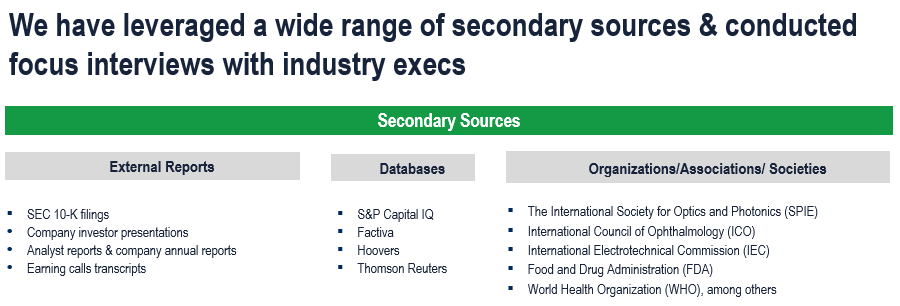
Primary Research
To validate research findings (market size & forecasts, market segmentation, market dynamics, competitive landscape, key industry trends, etc.), extensive primary interviews were conducted with both supply and demand-side stakeholders.
Supply Side Stakeholders:
- Senior Management Level: CEOs, Presidents, Vice-Presidents, Directors, Chief Technology Officers, Chief Commercial Officers
- Mid-Management Level: Product Managers, Sales Managers, Brand Managers, Business Development Managers, Consultants
Demand Side Stakeholders:
- Stakeholders in Hospitals, Research Laboratories, and Pharmaceutical & Biotechnology companies among others
Breakdown of Primary Interviews
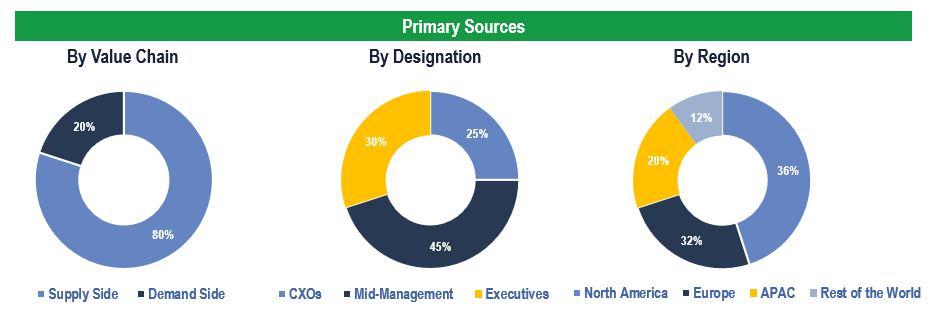
Market Size Estimation
Both ‘Top-Down and Bottom-Up Approaches’ were used to derive market size estimates and forecasts.
Data Triangulation
Research findings derived through secondary sources & internal analysis were validated with Primary Interviews, Internal Knowledge Repository, and Company Sales Data.

